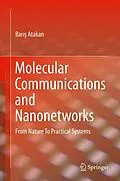In this book, the concepts of molecular communications and nanonetworks are introduced. Throughout the book, the existing molecular communication paradigms are categorized into two main groups. The first group includes the Passive Molecular Communication (PMC) paradigms in which molecules freely diffuse to transfer information from a transmitter to a receiver. The second group includes the Active Molecular Communication (AMC) paradigms in which molecules are carried or guided by some mediators such as molecular motors, gap junction channels and bacteria. In the book, after briefly discussing why molecular communication is needed for the sophisticated nano and biotechnology applications, the existing molecular communication systems are first presented. Then, the principles of diffusion phenomena and molecular reception with absorbers and the ligand-receptor binding mechanism are introduced. Based on these principles, the communication theories and techniques are given for the PMC. Then, the physical dynamics of molecular motors, calcium (Ca2+) signaling (with gap junction channels), cell-to-cell adhesion, motile behavior of bacteria are reviewed and based on these dynamics the AMC paradigms are discussed from the viewpoint of the communication theory.
Autorentext
Baris Atakan, PhD is currently at Izmir Institute of Technology.
Zusammenfassung
This book will introduce the concept of molecular communications and nanonetworks. The publication addresses why nanoscale communication is needed for the sophisticated nano and biotechnology applications. The text introduces the frontier applications of the molecular communication and nanonetworks. The book examines the molecular communication types called active, passive, and gap junction molecular communications. The author presents the molecular transmitter, receiver, encoding and decoding mechanisms used in these systems. Discussing the molecular communication system model and looking at the unique characteristics of practical molecular communication systems and these chemical reactions and their effects on the communication performance. Finally, the book examines the point-to-point, broadcast, and multiple-access molecular channel and shows two promising application examples of the nanonetworks. The first application example is the body area nanonetworks used in nanomedicine. the second nanonetwork application example, i.e., NanoSensor Networks (NSNs) with Molecular Communication.
Inhalt
Molecular Communication Among Nanomachines.- Passive Molecular Communication Through Absorbers.- Passive Molecular Communication Through Ligand-Receptor Binding.- Active Molecular Communication.
